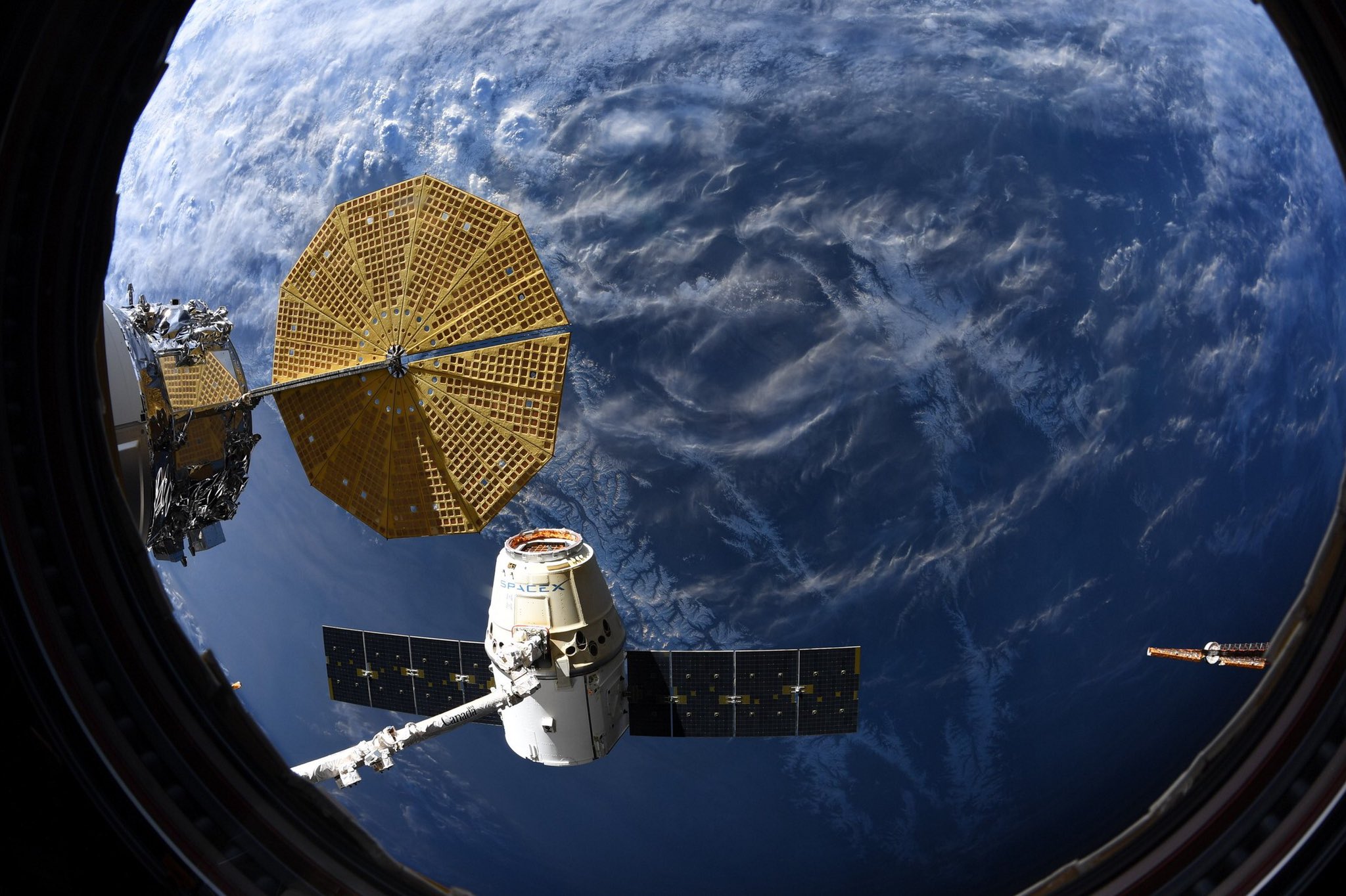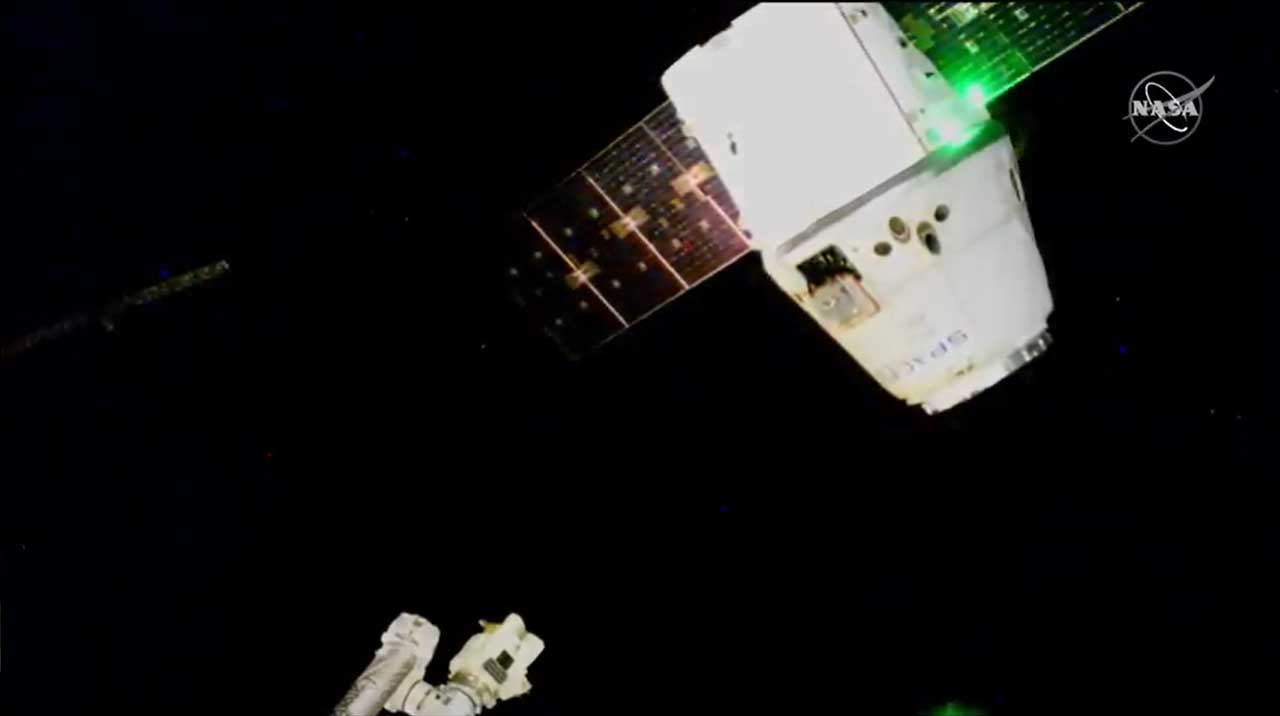SpaceX Dragon cargo ship, the last of its kind, returns to Earth from space station
Future Dragon cargo ships will have a new look.
A commercial Dragon cargo ship returned to Earth Tuesday (April 7), wrapping up a successful trip to International Space Station that heralded the end of one era and the start of another for its SpaceX builders.
The uncrewed Dragon CRS-20 spacecraft was released from the station's robotic arm at 9:06 a.m. EDT (1306 GMT) today as both spacecraft sailed high over Vietnam. It was just a moment, but marked the last time a robotic arm will ever catch or release a SpaceX Dragon.
About six hours after leaving the space station, Dragon splashed down in the Pacific Ocean just off the coast from Long Beach, California.
"Good splashdown of Dragon confirmed, completing the 20th and final resupply mission for SpaceX's first iteration of the Dragon spacecraft!" SpaceX said in a Twtitter update.
Dragon CRS-20, a veteran spacecraft that made three resupply runs to the space station, flew SpaceX's final mission of a $1.6 billion Commercial Resupply Service 1 contract with NASA. As its name suggests, the capsule is flying the 20th cargo mission for NASA and is also the last first-generation Dragon to fly. (The first Dragon 1 cargo ship visited the station in October 2012.)
Video: Watch SpaceX's last Dragon 1 cargo ship leave the space station
More: The evolution of SpaceX's rockets and spaceships in pictures

Now, SpaceX has a new version based on its Crew Dragon capsule for astronauts. Like that vehicle, the new cargo ship will be able dock itself to the station instead of an astronaut catching it with a robotic arm, like some sort of cosmic claw machine game. The first Crew Dragon vehicle made a successful uncrewed flight to the station last year.
Get the Space.com Newsletter
Breaking space news, the latest updates on rocket launches, skywatching events and more!
"That was the last time the arm and Dragon will meet that way," NASA astronaut Andrew Morgan said from inside the space station as Dragon was released. "So it was fun to watch."
SpaceX aims to launch its first Crew Dragon spacecraft with astronauts aboard in mid-May. The next cargo ship it launches for NASA will be under a new contract, called Commercial Resupply Service 2, and will feature a variant of Crew Dragon designed for cargo. Gone are the wing-like solar arrays, replaced by solar panels on the hull of the craft's service module. Also gone: a grapple fixture for the station's robotic arm to latch onto.
"The Dragon used in subsequent missions will resemble the Crew Dragon and will also automatically dock at the space station rather than require robotic action," NASA spokesperson Leah Cheshier said during live commentary.
Related: How SpaceX's Dragon space capsule works (infographic)

Dragon CRS-20 is carrying about 4,300 lbs. (1,950 kilograms) of scientific samples, gear and other items for the trip back to Earth. It will splash down in the Pacific Ocean, just off the coast of Long Beach, California, where SpaceX recovery teams are waiting to pluck the capsule from the ocean.
This Dragon capsule launched to the station on March 6 carrying more than 4,300 lbs. of supplies and arrived at the orbiting lab three days later. The same capsule previously flew to the station in February 2017 and December 2018.
Reusability is a hallmark of SpaceX's Dragon spacecraft (and the Falcon 9 rockets that launch them), but three flights has been the limit for the first-generation vehicles. The new Dragon 2 version is expected to be able to fly at least five times.
After a full month of exciting scientific payloads, #Cygnus and #Canadarm2 say goodbye to @SpaceX Dragon CRS-20 over central Asia at twilight. pic.twitter.com/ke7s2odcRnApril 7, 2020
The post-splashdown recovery will also see changes next flight.
Dragon CRS-20 is final Dragon to splash down in the Pacific Ocean. SpaceX has historically retrieved the vehicles off the Southern California coast so they can be refitted at the company's headquarters in Hawthorne, California near Los Angeles. Future Dragon spacecraft will splash down in the Atlantic Ocean off the Florida coast, SpaceX and NASA officials have said.
SpaceX is one of two companies currently flying uncrewed cargo missions to the station. The other, Northrop Grumman, uses its Antares rockets and Cygnus cargo ships to make space deliveries.
For the CRS-2 contract, NASA has again tapped SpaceX and Northrop Grumman, as well as Sierra Nevada Space Systems, which is building the uncrewed Dream Chaser space plane for orbital cargo missions.
Editor's note: This story has been updated to include the successful splashdown of Dragon CRS-20 in the Pacific Ocean.
- SpaceX's Crew Dragon Demo-1 test flight in pictures
- International Space Station: facts, history & tracking
- In photos: A behind-the-scenes look at SpaceX's Crew Dragon spaceship
Email Tariq Malik at tmalik@space.com or follow him @tariqjmalik. Follow us @Spacedotcom, Facebook and Instagram.
OFFER: Save 45% on 'All About Space' 'How it Works' and 'All About History'!
For a limited time, you can take out a digital subscription to any of our best-selling science magazines for just $2.38 per month, or 45% off the standard price for the first three months.
Join our Space Forums to keep talking space on the latest missions, night sky and more! And if you have a news tip, correction or comment, let us know at: community@space.com.

Tariq is the Editor-in-Chief of Space.com and joined the team in 2001, first as an intern and staff writer, and later as an editor. He covers human spaceflight, exploration and space science, as well as skywatching and entertainment. He became Space.com's Managing Editor in 2009 and Editor-in-Chief in 2019. Before joining Space.com, Tariq was a staff reporter for The Los Angeles Times covering education and city beats in La Habra, Fullerton and Huntington Beach. In October 2022, Tariq received the Harry Kolcum Award for excellence in space reporting from the National Space Club Florida Committee. He is also an Eagle Scout (yes, he has the Space Exploration merit badge) and went to Space Camp four times as a kid and a fifth time as an adult. He has journalism degrees from the University of Southern California and New York University. You can find Tariq at Space.com and as the co-host to the This Week In Space podcast with space historian Rod Pyle on the TWiT network. To see his latest project, you can follow Tariq on Twitter @tariqjmalik.










